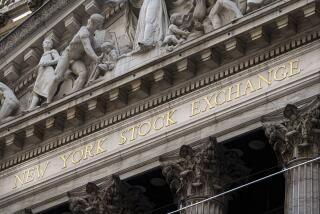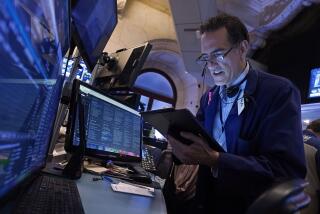FINANCIAL MARKETS : Late Computer Trading Pushes Dow Down 3.61
- Share via
NEW YORK — The stock market posted a small loss for the second straight session Thursday, yielding to some late selling by professional traders.
The Dow Jones index of 30 industrials closed with a 3.61 loss at 2,680.28.
Declining issues outnumbered advances by about 8 to 7 in nationwide trading of New York Stock Exchange-listed stocks, with 677 up, 750 down and 536 unchanged.
Before trading began, the Commerce Department reported that the nation’s gross national product grew at an annual rate of 2.5%, after adjustment for inflation, in the second quarter of the year. That came as a mild surprise to analysts, who had generally expected no change from the 2.7% estimate reported last month.
The resulting suggestion of a slower-than-expected pace of business activity helped stocks gain ground in early trading.
But after the advance faltered near the 2,700 level in the Dow industrial index, prices began to retreat.
Brokers said much of the late pressure on the market came from traders engaged in computer-program strategies involving stock index options and futures, and the prominent stocks that make up the indexes.
Chase Manhattan climbed 1/2 to 40 in active trading. Wall Streeters generally upgraded their appraisals of the company’s earnings outlook after its announcement late Wednesday of large writeoffs on its loans to less developed nations.
J. P. Morgan, which late Thursday announced a move similar to Chase’s, rose 1/8 to 39 3/4.
Kollmorgen fell 5 1/4 to 18 3/8 after Vernitron Corp. said it no longer wanted to proceed with a $25-a-share takeover of the company.
Big Board volume totaled 146.93 million shares, up from 136.64 million Wednesday. Nationwide, consolidated volume in NYSE-listed issues, including trades in those stocks on regional exchanges and in the over-the-counter market, totaled 173.11 million shares.
In Tokyo, the Nikkei Stock index of 225 selected issues gained 274.44, or 0.80%, closing at 34,745.02. The index began rising soon after the market opened as investors were reassured by the yen’s overnight jump against the dollar, dealers said.
In London, stock prices rallied in thin trading. The Financial Times-Stock Exchange 100-share index, the most closely watched market barometer, closed at 2,380.9, up 11.1, or 0.5%.
Credit
Bond prices fell slightly in light trading, extending losses earlier in the week.
The Treasury’s benchmark 30-year bond fell 1/4 point or $2.50 per $1,000 face amount. Its yield rose to 8.18% from 8.16% late Wednesday.
Some credit strategists said there was no particular reason for the weakness, which has depressed the long bond’s value by more than 1 point since Monday and pushed up short-term interest rates back over 8%.
Others attributed the weakness to declining investor expectations that the Federal Reserve will ease credit policy to stimulate the economy.
In the secondary market for Treasury bonds, prices of short-term governments fell 1/8 point, intermediate maturities fell about 7/32 point and long-term issues fell about 1/4 point, the Telerate Inc. financial information service reported.
The Shearson Lehman Hutton Daily Treasury Bond Index, which measures price movements on all outstanding Treasury issues with maturities of a year or longer, fell 1.34 to 1,175.34.
In the tax-exempt market, the Bond Buyer index of 40 actively traded municipal bonds fell 3/32 point. The average yield to maturity rose to 7.48% from 7.47% late Wednesday.
Yields on three-month Treasury bills rose to 8.08% as the discount rose 1 basis point to 7.82%. Yields on six-month bills rose to 8.16% as the discount rose 1 basis point to 7.74%. Yields on one-year bills rose to 8.23% as the discount rose 4 basis points to 7.68%.
The federal funds rate, the interest on overnight loans between banks, was quoted at 8.9375%, down from 9.75% late Wednesday. The 9.75% figure was considered a technical aberration caused by the end of a two-week reserve measurement period.
Currency
The dollar gained ground against the major currencies in quiet dealings.
Gold prices were unchanged to slightly higher. On the New York Commodity Exchange, an ounce finished at $365.50, up 60 cents from Wednesday. Republic National Bank later quoted a bid of $363.85, up 25 cents.
Recent statements by Japanese and West German officials indicated some concern about the dollar’s strength. But a regularly scheduled meeting of Bundesbank officials Thursday failed to result in an expected hike in West German interest rates.
Some traders are anticipating higher West German and Japanese interest rates in tandem with softer rates in the United States, a scenario that would depress the dollar.
Separately, the dollar failed to respond to the Commerce Department’s downward revision in the second-quarter gross national product.
In Tokyo, where trading ends before Europe’s business day begins, the dollar fell 1.25 yen to a closing 145.00 yen. Later in London, it was quoted at a higher rate of 145.10 yen. In New York, the dollar closed at 145.65 yen, up from 145.10 yen on Wednesday.
In London, the dollar gained against the British pound. It cost $1.5805 to buy one pound, cheaper than $1.5820 late Wednesday. In New York, one pound cost $1.5790, less expensive than Wednesday’s $1.5835.
Gold held steady in London at a late bid of $363.25, unchanged. In Zurich, gold also was unchanged at $363.50 bid. Earlier in Hong Kong, gold rose $2.69 to close at $364.11 bid.
Silver prices rose. On New York’s Comex, silver closed at $5.181 an ounce, up from $5.119 on Wednesday. Earlier in London, the metal was trading at a late bid price of $5.14 an ounce, compared to Wednesday’s $5.13.
Commodities
Prices of grain and soybean futures rallied strongly on the Chicago Board of Trade as the markets braced for the first hard freeze of the season in the Midwest.
On other markets, silver futures were sharply higher for the second consecutive session, energy futures were mixed, and livestock and meat futures were mixed.
Wheat futures settled 2 to 3 cents higher, with the contract for delivery in December at $3.94 3/4 a bushel; corn futures were unchanged to 3 cents higher, with December at $2.31 1/2 a bushel; oats were 1 1/2 to 2 cents higher, with December at $1.41 1/2 a bushel; soybeans were 3 cents lower to 7 1/4 cents higher with November at $5.82 3/4 a bushel.
The rally was rooted in forecasts for freezing temperatures this weekend and early next week, possibly reaching as far south as northern Arkansas and Tennessee.
“This is record-breaking or near-record-breaking type cold coming in,” said Charles Notis of Freese-Notis Weather Inc., a private forecasting firm in Des Moines, Iowa.
Most corn and soybean crops west of the Mississippi River and in Illinois have matured beyond the danger stage. But the crops in other Midwestern states east of the Mississippi--especially soybeans--are susceptible to freeze damage.
In the western Corn Belt, where the crops are more mature, “I don’t think you’re talking about yield losses, I think you’re talking about quality problems,” said Dale Gustafson, an analyst with Drexel Burnham Lambert Inc.
Silver futures scooted up sharply on New York’s Commodity Exchange as the dollar weakened. Gold futures made only slight gains, held back by the oil market’s lackluster showing.
Gold settled 10 to 60 cents higher, with October at $366.30 an ounce; silver was 6 to 6.4 cents higher, with September at $5.181.
Livestock and meat futures finished mixed on the Chicago Mercantile Exchange.
Live cattle were 0.25 cent lower to 0.55 cent higher, with October at 71.70 cents a pound; feeder cattle were 0.15 cent lower to 0.20 cent higher, with September at 83.10 cents a pound; hogs were 0.43 cent lower to 0.13 cent higher, with October at 41.90 cents a pound, and frozen pork bellies were 1.10 cents lower to 0.60 cent higher, with February at 48.75 cents a pound.
Tables, Page 6
More to Read
Inside the business of entertainment
The Wide Shot brings you news, analysis and insights on everything from streaming wars to production — and what it all means for the future.
You may occasionally receive promotional content from the Los Angeles Times.










